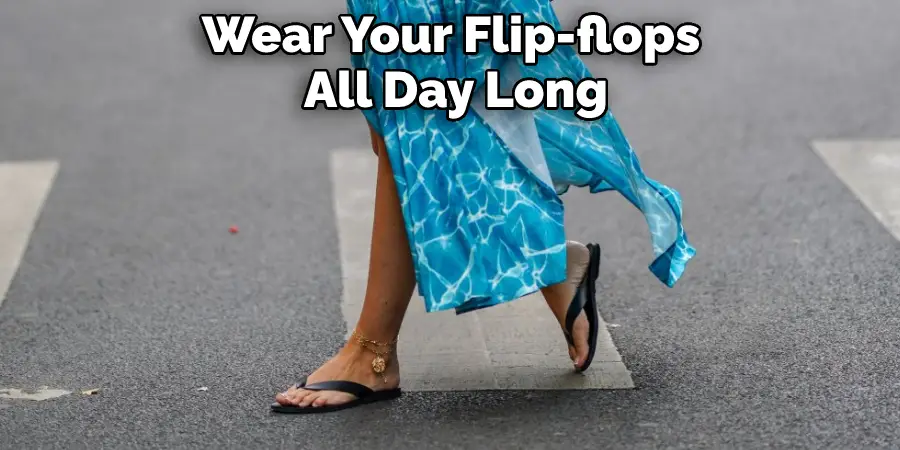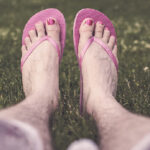If you’re like most flip-flop wearers, then you know the joys and pains of having these versatile shoes in your closet. From beach strolls to lazy weekend afternoons at home, there’s no denying that on-the-go comfort is found with a simple pair of flip-flops. But for some unfortunate souls, the experience can be dampened by chafed toes or raw skin from ill-fitting toe separators!

If this sounds familiar and you’re looking for an easy way to stop flip-flops from rubbing between your toes, then look no further! This blog post will walk you through tried and true methods how to stop flip flops from rubbing between toes while keeping both feet happy and pain-free. So keep reading to learn everything you need to know about stopping rub misery – it’s time to put those enjoying days in sandals back in motion!
Why Do Thong Sandals Hurt between Toes?
To understand how to stop flip flops from rubbing between toes, it helps to first understand why they hurt in the first place. Generally speaking, thong sandals rub against the toes because of a combination of three primary factors:
1. Poor Fit:
Flip-flops that don’t fit properly – either too small or too loose – are the most common cause of irritation between the toes. The toe separator should fit snugly against your foot, with the sides touching but not squeezing too tight.
2. Poor Quality:
Cheap, poorly-made flip-flops can easily lead to chafing and sore toes because of a lack of support and cushioning. Opt for better quality, branded flip-flops made from breathable materials such as rubber or leather.
3. Excessive Activity:
If you wear your flip-flops all day long, then you’re more likely to experience pain between your toes due to excessive movement of the sandal straps. To reduce this risk, limit your time in flip-flops and opt for supportive shoes if you’re going to be on your feet for extended periods.

10 Methods on How to Stop Flip Flops from Rubbing between Toes
1. Choose the Right Size
One of the most important things you can do to prevent your flip-flops from rubbing between your toes is to choose the right size. Flip flops that are too small will inevitably rub against your skin, causing irritation and discomfort. Make sure to try on a few different pairs before you buy to ensure you find a pair that fits well. If you’re ordering online, it’s important to check the sizing chart to make sure you order the right size.
2. Look for Padded Insoles
Another way to prevent your flip-flops from rubbing between your toes is to look for a pair that has padded insoles. These will provide a layer of cushioning between your feet and the sandals, making it less likely that they will rub and cause irritation. If you already have a pair of flip-flops without the padding, you can try adding your own insoles for extra comfort. Make sure that the insoles you choose are designed specifically for flip-flops so that they will fit correctly and stay in place.
3. Apply Powder or Baby Talc
If you already have a pair of flip-flops that are rubbing between your toes, you can try applying some powder or baby talc to the areas that are most prone to rubbing. This will help to absorb any moisture and reduce friction. You can also use a foot deodorant to help prevent your feet from sweating.

Just make sure to apply it sparingly so that it doesn’t cause more friction. While this may not completely solve the problem, it can offer some relief until you find a better pair of flip-flops. However, it is important to note that using powder or baby talc could make your feet even more slippery and increase the risk of slipping on wet floors.
4. Wear Socks with Your Flip Flops
If you find that your flip-flops are still rubbing between your toes, even after trying the above tips, you can always try wearing socks with them. This may not be the most stylish option, but it will definitely prevent any discomfort. If you opt for this option, make sure to choose a pair of socks that is thin and breathable, so your feet don’t get too hot and sweaty.
Additionally, you could always try a pair of lightweight no-show socks that won’t be visible but will still provide the extra padding and protection you’re looking for. At the end of the day, do whatever works best for your feet and makes them feel most comfortable.
5. Use Moleskin or Band-Aids
Another option for preventing your flip-flops from rubbing between your toes is to use moleskin or band-aids. You can apply these directly to the areas that are prone to rubbing, which will create a barrier and protect your skin. Moleskin is a soft fabric that usually comes in sheets and can be cut to the shape of your foot.
Band-aids provide even more cushion and protection, but they are not as durable as moleskin. If you plan to wear your flip-flops for an extended period of time, moleskin is the better choice. Both of these products can be purchased at most drug stores or online. Additionally, most athletic stores carry specialized moleskin or band-aids made specifically for feet.
6. Break in Your Flip Flops Slowly
If you have a new pair of flip-flops that are giving you trouble, try breaking them in slowly. Start by wearing them around the house for short periods of time, gradually increasing the amount of time you spend in them each day. This will help them mold your feet better and hopefully prevent any rubbing.
If they’re still uncomfortable, try using a bandage or moleskin on areas that are rubbing, as this can help. It may also help to wear socks while you break them in, as this can give your feet a bit of extra cushioning. Breaking in your flip-flops slowly can help to ensure you get the most out of your purchase and avoid any unnecessary discomfort.
7. Adjust the Straps
If the straps on your flip-flops are too tight, this can also cause them to rub between your toes. Try loosening them up a bit, so they’re not as snug against your feet.
You may need to experiment with different strap positions until you find one that’s comfortable and doesn’t cause any rubbing. If the straps are too loose, try tightening them up for a better fit. It’s important to adjust the straps so that your feet stay secure in the flip-flops but not so tight that they’re uncomfortable.

8. Wear Flip-Flops with Heels
If you’re trying to avoid the painful rubbing that comes with wearing flip-flops, you can also invest in a pair with heels or wedges. The added height will help to keep your feet from sliding forward too much and create more cushioning between your toes.
Plus, the extra support of a wedge makes it easier to wear them for long periods of time without any discomfort. Although these types of flip-flops may not be ideal for the beach or pool, they can be a great way to stay comfortable during summer errands or night outs.
9. Wear Flip-Flops with Socks
Wearing socks with your flip-flops may not seem like the most stylish look, but it can help to prevent painful rubbing. The extra layer of fabric between your toes helps to create a cushion and also prevents dirt and debris from getting into your shoes.
You can find special flip-flop socks that are designed specifically for this purpose, or just wear regular socks with your sandals. While this may not be the most fashionable option, it can help keep your feet comfortable and protected.
10. Add Some Gel Inserts
Gel inserts can also help to prevent your flip-flops from rubbing between your toes. They provide extra cushioning and support, which makes it less likely that they will rub and cause irritation. You can find gel inserts at most drugstores or online retailers.
They’re easy to install, and you can use them in any kind of flip-flop. Just make sure that the gel insert fits snugly into the shoe to ensure a comfortable fit. Try to find ones that have an anti-slip surface for added stability. With the right pair of gel inserts, you can enjoy your flip-flops without having to worry about uncomfortable rubbing.

Conclusion
If you suffer from the dreaded flip-flop rub, don’t worry, there are a few things you can do to ease your discomfort. First, try wearing thong-style flip-flops, which put less pressure on your toes.
Alternatively, try applying a band-aid or moleskin to the area between your toes before putting on your flip-flops. Finally, make sure your flip-flops fit properly; if they’re too big or too small, they will rub more. With these tips in mind, go enjoy summer without having to worry about painful blisters!
We hope this guide on how to stop flip flops from rubbing between toes was helpful. Please share it with your friends on social media if you find it useful. And be sure to check back here soon for more informative guides like this one.




